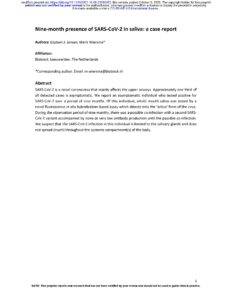Wetenschappelijke Publicaties
Bij NL-Lab zijn al onze analyses gebaseerd op degelijke wetenschappelijke literatuur. Ons onderzoek en onze technieken zijn zorgvuldig ontwikkeld en gevalideerd door middel van uitgebreide wetenschappelijke studies. Op deze pagina vind je een overzicht van onze huidige gepubliceerde wetenschappelijke artikelen, die onderwerpen behandelen zoals fluorescentie in situ hybridisatie (FISH), de detectie van SARS-CoV-2 in speeksel en innovatieve methoden voor het kwantificeren van fluorescent gelabelde bacteriën. Verken deze publicaties om meer te weten te komen over de wetenschappelijke basis die onze innovatieve aanpak ondersteunt en ontdek de diepgang van ons onderzoek in microbiologische analyse en pathogeen detectie.
Advancements in analytical methods for studying the human gut microbiome
The human gut microbiome, a complex ecosystem of microorganisms, plays a crucial role in maintaining human health. Perturbations in its composition are linked to a wide range of health conditions. Researchers employ various techniques to study the gut microbiome, each…
Evaluation of a fluorescence in situ hybridization (FISH)-based method for detection of SARS-CoV-2 in saliva
The use of a non-invasive fluorescence in situ hybridization (FISH)-based method on saliva for the detection of SARS-CoV-2 is evaluated in a proof-of-concept study and thereafter utilized in an outpatient setting with the Biotrack-MED® analyzer. For a proof-of-concept study…
Direct detection of SARS-CoV-2 antisense and sense genomic RNA in human saliva by semiautonomous
fluorescence in situ hybridization: A proxy for contagiousness?
Saliva is a matrix which may act as a vector for pathogen transmission and may serve as a possible proxy for SARS-CoV-2 contagiousness. Therefore, the possibility of detection of intracellular SARS-CoV-2 in saliva by means of fluorescence in situ hybridization…
Nine-month presence of SARS-CoV-2 in saliva: a case report
SARS-CoV-2 is a novel coronavirus that mainly affects the upper airways. Approximately one third of all detected cases is asymptomatic. We report an asymptomatic individual who tested positive for SARS-CoV-2 over a period of nine months,…
Development and validation of an alternative parameter for quantification of signals emitted by fluorescently labelled bacteria in microscopic images
In this study, an alternative parameter for quantifying the signals of fluorescently labelled bacteria (e.g. propidium iodide, Cyanine 3, etc.) in microscopic images was investigated. Three common parameters (mean grey value (MGV), mean grey value which is corrected…
Tamminga, G. G., Paulitsch-Fuchs, A. H., Jansen, G. J., & Euverink, G. J. W. (2019). Development and validation of an alternative parameter for quantification of signals emitted by fluorescently labelled bacteria in microscopic images. Journal of Microbiological Methods, 166. https://doi.org/10.1016/j.mimet.2019.105717
Different binarization processes validated against manual counts of fluorescent bacterial cells
State of the art software methods (such as fixed value approaches or statistical approaches) to create a binary image of fluorescent bacterial cells are not as accurate and precise as they should be for counting bacteria and measuring their area. To overcome these bottlenecks,…
Tamminga, G. G., Paulitsch-Fuchs, A. H., Jansen, G. J., & Euverink, G. J. W. (2016). Different binarization processes validated against manual counts of fluorescent bacterial cells. Journal of Microbiological Methods, 128. https://doi.org/10.1016/j.mimet.2016.07.003







